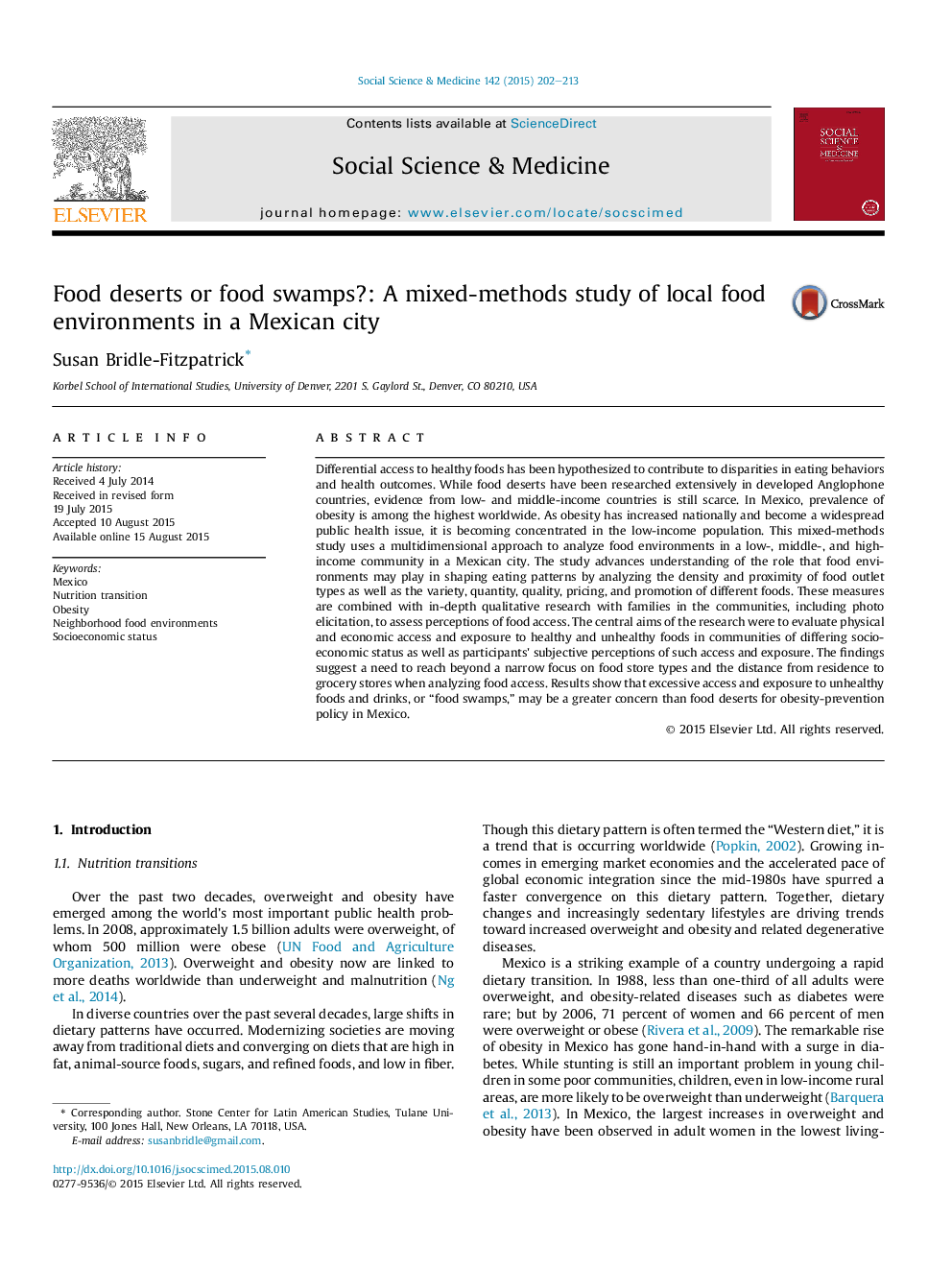| کد مقاله | کد نشریه | سال انتشار | مقاله انگلیسی | نسخه تمام متن |
|---|---|---|---|---|
| 7331766 | 1476027 | 2015 | 12 صفحه PDF | دانلود رایگان |
عنوان انگلیسی مقاله ISI
Food deserts or food swamps?: A mixed-methods study of local food environments in a Mexican city
ترجمه فارسی عنوان
بیابان مواد غذایی یا سفره های غذا: یک روش ترکیبی از محیط های غذایی محلی در یک شهر مکزیکی است
دانلود مقاله + سفارش ترجمه
دانلود مقاله ISI انگلیسی
رایگان برای ایرانیان
کلمات کلیدی
مکزیک، انتقال تغذیه، چاقی، محیط غذایی محله، وضعیت اجتماعی و اقتصادی،
ترجمه چکیده
دسترسی دیفرانسیل به غذاهای سالم فرض شده است که موجب ناهماهنگی در رفتارهای خوردن و نتایج سلامتی می شود. در حالی که بیابانهای غذا به شدت در کشورهای توسعه یافته زبان انگلیس مورد تحقیق قرار گرفته است، شواهدی از کشورهای کم درآمد و متوسط درآمد هنوز کم است. در مکزیک، شیوع چاقی یکی از بالاترین در سراسر جهان است. همانطور که چاقی به طور ملی افزایش یافته و به یک موضوع بهداشت عمومی گسترده تبدیل شده است، در جمعیت کم درآمد متمرکز شده است. این مطالعه ترکیبی از روش یک روش چند بعدی برای تجزیه و تحلیل محیط غذا در یک جامعه کم، متوسط و با درآمد بالا در یک شهر مکزیکی است. این مطالعه درک نقش نقش محیط غذا در شکل دهی الگوهای غذا را با تحلیل تراکم و نزدیکی انواع مواد غذایی و همچنین تنوع، کمیت، کیفیت، قیمتگذاری و ارتقاء غذاهای مختلف، درک می کند. این ارزیابی ها با تحقیقات کیفی جامع و با خانواده های جوامع، از جمله ایجاد عکس، برای ارزیابی ادراک دسترسی به مواد غذایی، ترکیب شده است. هدف اصلی این تحقیق، ارزیابی دسترسی فیزیکی و اقتصادی و قرار گرفتن در معرض غذاهای سالم و ناسالم در جوامع مختلف وضعیت اجتماعی-اقتصادی و همچنین درک ذهنی شرکت کنندگان از چنین دسترسی و قرار گرفتن در معرض آنها بود. یافته های این پژوهش نشان می دهد که در هنگام تجزیه و تحلیل دسترسی به مواد غذایی نیاز به فراتر رفتن از تمرکز محدود بر روی انواع فروشگاه های مواد غذایی و فاصله از محل اقامت تا فروشگاه های مواد غذایی است. نتایج نشان می دهد که دسترسی بیش از حد و قرار گرفتن در معرض غذاها و نوشیدنی های ناسالم و یا مواد مخدر مواد غذایی ممکن است نگران کننده تر از بیابان های غذایی برای سیاست پیشگیری از چاقی در مکزیک باشد.
موضوعات مرتبط
علوم پزشکی و سلامت
پزشکی و دندانپزشکی
سیاست های بهداشت و سلامت عمومی
چکیده انگلیسی
Differential access to healthy foods has been hypothesized to contribute to disparities in eating behaviors and health outcomes. While food deserts have been researched extensively in developed Anglophone countries, evidence from low- and middle-income countries is still scarce. In Mexico, prevalence of obesity is among the highest worldwide. As obesity has increased nationally and become a widespread public health issue, it is becoming concentrated in the low-income population. This mixed-methods study uses a multidimensional approach to analyze food environments in a low-, middle-, and high-income community in a Mexican city. The study advances understanding of the role that food environments may play in shaping eating patterns by analyzing the density and proximity of food outlet types as well as the variety, quantity, quality, pricing, and promotion of different foods. These measures are combined with in-depth qualitative research with families in the communities, including photo elicitation, to assess perceptions of food access. The central aims of the research were to evaluate physical and economic access and exposure to healthy and unhealthy foods in communities of differing socioeconomic status as well as participants' subjective perceptions of such access and exposure. The findings suggest a need to reach beyond a narrow focus on food store types and the distance from residence to grocery stores when analyzing food access. Results show that excessive access and exposure to unhealthy foods and drinks, or “food swamps,” may be a greater concern than food deserts for obesity-prevention policy in Mexico.
ناشر
Database: Elsevier - ScienceDirect (ساینس دایرکت)
Journal: Social Science & Medicine - Volume 142, October 2015, Pages 202-213
Journal: Social Science & Medicine - Volume 142, October 2015, Pages 202-213
نویسندگان
Susan Bridle-Fitzpatrick,
